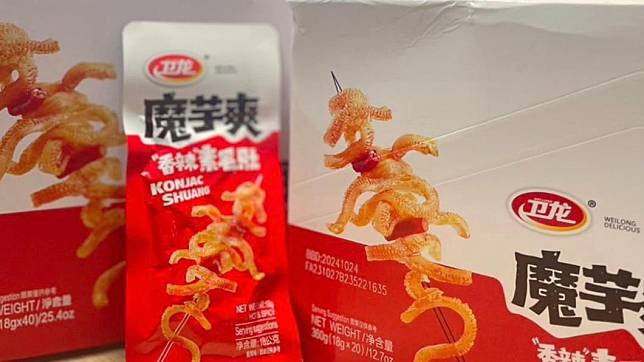What is Konjac Shuang?
Konjac Shuang(Chinese: 魔芋爽, 魔芋-Konjac, Shuang/Jelley-爽) is a popular snack made primarily from konjac flour, starch, and a generous amount of seasonings. Its appearance resembles that of tripe, which is why it’s also known as “Vegetarian Tripe,” although it has no actual relation to tripe. A key ingredient in Konjac Shuang is sodium; for example, the Wei Long brand of Konjac Shuang contains as much as 1262 milligrams of sodium per 100 grams. Konjac itself is a tropical plant that becomes edible only after processing, containing a rich amount of glucomannan. This substance is known for its ability to increase feelings of fullness. Consuming konjac in moderation can help control blood sugar levels, improve constipation, reduce cholesterol and blood lipids, and supplement calcium intake. However, caution is advised to avoid excessive consumption, as some konjac products may contain a high level of additives, such as sodium. Excessive intake of these can lead to health issues like high blood pressure. Therefore, despite the benefits of konjac, it’s important to consume it judiciously to maintain health.
The History of Konjac Shuang
Konjac Shuang, a spicy snack sensation, was launched by Wei Long Delicious Global Holdings Ltd. on July 25, 2014. Favored for its spicy and smooth texture, it quickly won over consumers, spreading its reach across China and over 30 countries and regions, including the United States, the United Kingdom, Australia, Germany, Japan, and South Korea. The origin of Konjac Shuang dates back to 2014 when Wei Long, inspired by “konjac tofu,” developed this new spicy snack and named it “Konjac Shuang.” The product officially hit the market on July 25, 2014, following a launch event at the Luohe International Convention and Exhibition Center, which was extensively covered by China National Radio.
Over time, Konjac Shuang has gained market recognition and consumer affection. In 2017, the product was honored with the “Annual Convenience Food Innovation Award,” further establishing its status in the snack market. In June 2022, Konjac Shuang received certificates for “China’s Leading Sales Volume” and “Global Leading Sales Volume” from Frost & Sullivan, reaffirming its outstanding performance in the industry. In August of the same year, CCTV’s “Super Factory” program featured the Wei Long factory, including the production of Konjac Shuang, acknowledging its production process and product quality.
In summary, Konjac Shuang, with its unique taste and spicy flavor, has achieved remarkable success in just a few years since its inception in 2014. Through continuous innovation and marketing, it has become a beloved snack brand, enjoying success both domestically and internationally.
Is Konjac Shuang a healthy snack?
There are some nutritional issues with Konjac Shuang. Although Konjac Shuang is low in calories, it usually contains high-fat, high-sodium seasonings, such as colorings and MSG. These ingredients may burden the liver and kidneys, leading to health issues like high blood pressure. This is especially true for children. Consuming too much Konjac Shuang could affect their concentration, learning ability, and emotional management skills. According to modern healthy eating concepts, the daily sodium intake for both children and adults should be controlled, and the sodium content in Konjac Shuang may exceed part of these recommended intake levels.
Overall, Konjac Shuang is not a healthy snack choice, especially long-term excessive consumption may have a negative impact on health. Therefore, in order to maintain physical health, it is recommended to consume Konjac Shuang in moderation and pay attention to a balanced diet, choosing snacks that are more nutritious and low in additives.
But apart from this, Konjac Shuang is a safe snack.
How many calories are in Konjac Jelly?
Konjac itself has no calories, so the calories in Konjac Shuang mainly come from its seasoning. The calories in Konjac Shuang vary depending on the product and weight. Generally speaking, every 100 grams of Konjac Shuang has about 123 to 184 calories. Specifically, a 22 gram packet of Konjac Shuang contains about 30 kilocalories.
The Top Three Konjac Jelly Brands in China:
Wei Long Konjac Jelly:

Wei Long Konjac Jelly stands out as a highly popular snack, offering three flavors: Classic Spicy, Sichuan-Chongqing Spicy, and Sour & Spicy Pickled Pepper. Garnering unanimous praise from over 300,000 online users, it’s renowned for its impressive rating of 4.9. As a national-level enterprise, Wei Long’s Konjac Jelly is celebrated for its miraculous texture and chewiness, boasting a thinner and more refreshing bite.
Three Squirrels:

Three Squirrels shines as another leading brand in the Konjac Jelly market. Known as one of the top internet brands for nut sales, it enjoys a prestigious reputation in the national nuts and snacks sector. Their Konjac Jelly products have captured the market’s attention, becoming a favored choice among consumers.
Yan Jin Pu Zi:

Yan Jin Pu Zi ranks as another leading Konjac Jelly brand in China, playing a significant role in the 40 billion yuan Konjac market. Its products are beloved by consumers for their quality. Not only does Yan Jin Pu Zi offer traditional flavors, but it also continuously innovates with new tastes to cater to a diverse range of consumer preferences.
